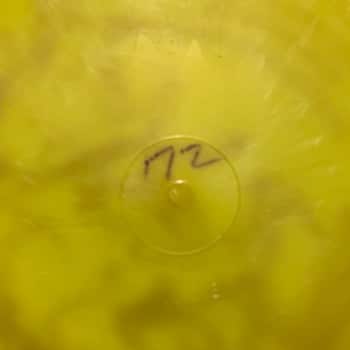While it’s easy to understand most disc weights will fall between 165- 175 grams it could be hard to imagine how that little difference can actually make in our throws. Generally speaking lighter discs will be more understable and heavier discs will be overstable. For beginners, lighter discs can get them a nice turnover resulting in longer flights.
Common Disc Weights
Most discs weights fall between 165 to 175 grams. The PDGA limits the weight of discs to 200 grams. I’ve seen articles that put the PDGA limit to putters and drivers to 175 grams but I can’t seem to confirm that on their site.
Here is a link to the PDGA specifications on discs and other equipment. Companies will make heavier discs you just won’t be able to use them in PDGA sanctioned events.
Drivers under 170 grams are perfect for beginners. Junior players will find the 150 Class weights ideal for learning. The 150 Class refers to the super lightweights mostly used by beginners, juniors, and senior players.
Most junior and adult players should start out with the lighter drivers under 170 grams. While advanced players will max out their driver weights do not believe that you mst do the same. Every player’s arm speed is different.
Check out my article Best Disc Golf Drivers For Beginners That Anyone Can Throw and check out those discs in lighter plastics.
Mid-range discs are often heavier than 175 grams as they are wider and have thicker rims. Beginners should look into discs around 170 grams. Advanced players will usually max out their mid-range discs to 180 grams.
Putters come in light and heavyweights as well. Heavier putters will perform better in the winds and for harder throws. Light putters would be 170-172 grams on average and heavier putter will be about 173-175 grams.
Most Beginner Disc Golf Sets that I mention come in the lighter weights perfect for getting started.
Where To Find The Disc Weight

Increased Speed With Lighter Discs
To get a good predictable flight out of any disc you must get it up to speed. In order to get a disc up to speed, you have to keep it spinning while it is moving through the air.
Heavy discs are harder for beginners to get spinning through the air sufficiently for a nice long flight. If a heavy disc loses its spin and then speed it will end its flight early and or land at an undesirable angle.
Lighter discs on the other hand are easier to obtain a good spin on. Beginners and pros alike can easily spin these discs and therefore get more distance with them than heavier discs.
Lighter Discs Can Get More Distance
Lighter discs thrown at optimal speeds will get a longer flight usually equating to more distance. Getting the disc spinning properly will increase distance. But now that we have a lighter disc we can also get it moving through the air faster as well.
This alone will increase the disc’s flight speed equalling more distance. Lighter discs are easier for beginners to reach back and pull forward with enough velocity to get the disc up to speed.
When To Throw Lighter Discs
Throwing a lighter disc uphill is a perfect idea for more distance uphill. Generating that momentum for uphill drives and approaches is not as easy and so lighter discs will greatly improve your uphill drives.
Light discs are perfect for tailwind drives! A tailwind is when the wind is coming from behind you. Tailwinds slow down your disc while in flight. If you throw a heavy disc in a tailwind it better be moving fast.
Lighter discs and slower speed discs can be a perfect combination in a disc for beginners throwing in a tailwind.
When To Throw Heavier Discs
Heavy discs usually have more stability and are perfect for throwing into the wind. The wind wants to flip your disc over and the heavier discs will resist that flip with a stronger fade at end of its flight than lighter discs.
If your home course that you play regularly is pretty gusty you may want to choose heavier discs to help combat that wind. Putting with a heavy putter is a great idea in windy situations. Their weight will help them sit down on the ground faster and usually will have a little less glide as well.
Special Lighter Disc Plastics
Most disc golf manufacturers have a super lightweight plastic blend. This is commonly achieved by injecting air bubbles into the disc mold using less plastic thus resulting in a lighter disc.
You’ll often hear this plastic referred to as bubble plastic across multiple brands.
Innova is known for its Blizzard Champion plastic. These discs get as low as 130 grams. They’re durable, reliable, and high-quality plastic. This plastic is created by injecting microbubbles into their Champion plastic.
The Beast from Innova is a great way to disc up to a faster speed disc in a lighter weight. Click to get a Beast from infinitediscs
Discraft has its Z Lite discs that come in weights as low as 140 grams. These disc are also super durable and high-quality plastic. The Z Lite has a little less grip than their other stock plastics but should be a great choice for your bag.
A Cyclone would be a perfect lightweight driver from Discraft. Click to get a Cyclone from infinitediscs
Dynamic Disc has a Lucid Air plastic that is very similar. These discs get as low as 155 grams. Microbubbles are placed in their Lucid plastic that like the others is durable and reliable plastic. Dynamic Discs also has an Opto Air line for their Opto plastic and a VIP Air plastics type for their Westside Discs molds.
Bag an Escape in Dynamics Discs Lucid Air plastic and watch this add some distance to your drives. Click to get a Lucid from infinitediscs
What Weights Should I Have In My Bag
As you might have guessed lighter discs are good to start with. They’re not the only ones you should have though.
Some may want to start with medium weight discs especially if they live in windy conditions or naturally have stronger arms.
Find what weight works best for you. Then you might want to try a lighter or “bubble plastic” in your favorite driver.
You also might want to try a heavier putter for those gusty days. Buy two of your favorite putters of the same weight. Then get one that’s at max weight for windy conditions.
As you’re playing and learning, think about disc weight and always take note of disc weights when trying out other random discs. Variety is the spice of life and that goes for disc weights too. Don’t always feel like the heaviest disc is the best, coolest, or makes you look strong.
Disc weights fall right in line when you understand the discs flight patterns and how they all work together. You might find this post useful: Disc Golf Discs Flight Guides And Number Systems Explained


